
Darkling beetle is the common name for members of the beetle family Tenebrionidae, comprising over 20,000 species in a cosmopolitan distribution.

The Tenebrionoidea are a very large and diverse superfamily of beetles. It generally corresponds to the Heteromera of earlier authors.

Pimelia is a genus of darkling beetles in the subfamily Pimeliinae.

Tenebrioninae is the largest subfamily of the darkling beetles (Tenebrionidae), containing flour beetles, among others. Tenebrioninae contains more than 20 tribes.
Trachelostenus is a genus of darkling beetles in the family Tenebrionidae. It is native to the Valdivian forests of Chile, and has at least two species, T. inaequalis (Solier) and T. fascicularis (Philipp). It was historically considered the only member of the family Trachelostenidae, but a 2015 study sunk the genus into the tenebrionid subfamily Tenebrioninae.

Epicauta is a genus of beetles in the blister beetle family, Meloidae. The genus was first scientifically described in 1834 by Pierre François Marie Auguste Dejean. Epicauta is distributed nearly worldwide, with species native to all continents except Australia and Antarctica. Surveys have found the genus to be particularly diverse in northern Arizona in the United States. Few species occur in the Arctic, with none farther north than the southern Northwest Territory of Canada.

The Sepidiini is a tribe of ground-dwelling darkling beetles (Tenebrionidae), that occurs across Africa, the Mediterranean Basin, the Arabian Peninsula and Mesopotamia. It is composed of many hundreds of species. The larvae of some species are known to damage crops.

The Tapering darkling beetles (Hymatismus) are an Afrotropical genus of darkling beetles (Tenebrionidae). They are elongate or oval-shaped, with pointed abdomens and protruding eyes. The elytra show longitudinal bands, and like the head and pronotum, are covered with unevenly distributed yellow hairs. They are lethargic scavengers occupying a catholic range of habitats.

The helmet toktokkies are ground-dwelling, Afrotropical beetles in the family Tenebrionidae.
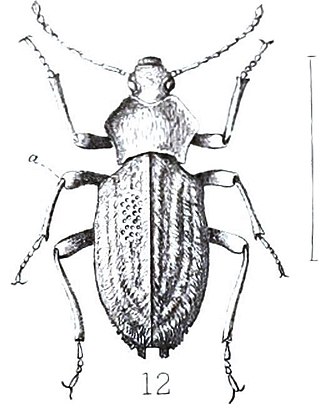
Hypomelus is a genus of beetles of the family Tenebrionidae. It is the type genus of the Hypomelina subtribe.

Asidini is a tribe of darkling beetles in the subfamily Pimeliinae of the family Tenebrionidae. There are more than 30 genera in Asidini.
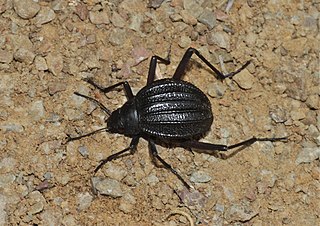
Stenocara is a genus of darkling beetles which is native to southern Africa. Several species are endemic to Namibia.

Hypomelina is a subtribe of darkling beetles in the family Tenebrionidae. There are about 9 genera and more than 40 described species in Hypomelina, found mainly in southern Africa. The majority of species were described from the Namibian coast, and only the genus Bombocnodulus is found as far north as central Africa.

Molurina is a subtribe of darkling beetles in the family Tenebrionidae. There are 28 genera and 579 described species and subspecies in subtribe Molurina. The type genus for this subtribe is Moluris. These beetles are widely distributed through the Afrotropics, with the exception of western Africa.

Trachynotina is a subtribe of darkling beetles in the family Tenebrionidae. There are about 10 genera and more than 170 described species in Trachynotina, found in southern Africa. Although Sepidiini species attract the attention of enthusiasts due to their outstanding morphology and behaviour, the group lacks comprehensive revisions at all taxonomic levels.
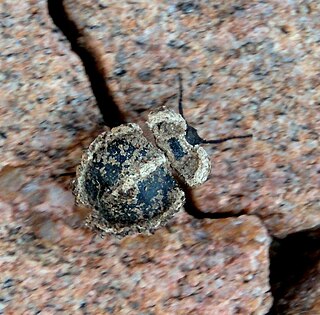
Adelostomini is a tribe of darkling beetles in the subfamily Pimeliinae of the family Tenebrionidae. There are more than 30 genera in Adelostomini, found primarily in tropical Africa.
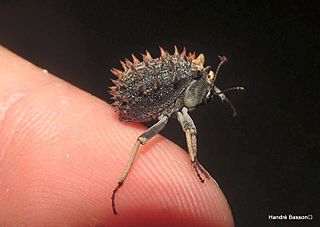
Cryptochilini is a tribe of darkling beetles in the subfamily Pimeliinae of the family Tenebrionidae. There are about 11 genera in Cryptochilini, found in tropical Africa.

Tentyriini is a tribe of darkling beetles in the subfamily Pimeliinae of the family Tenebrionidae. There are more than 90 genera in Tentyriini.
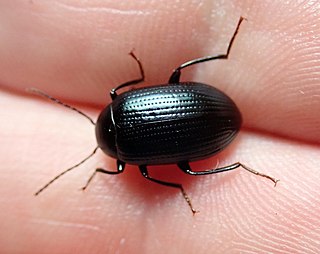
Amarygmini is a tribe of darkling beetles in the family Tenebrionidae. There are more than 80 genera in Amarygmini.

Mariazofia is a genus of ground-dwelling Afrotropical beetles in the family Tenebrionidae. They are among the largest of the darkling beetles. Like other genera within subtribe Molurina, adults of this genus engage in a behavior known as "substrate tapping", a form of sexual communication in which they produce vibrations by tapping their abdomen rhythmically on the ground to attract mates. Their common name, "tok-tok beetle" or "toktokkie beetle", is based on this behavior.


















